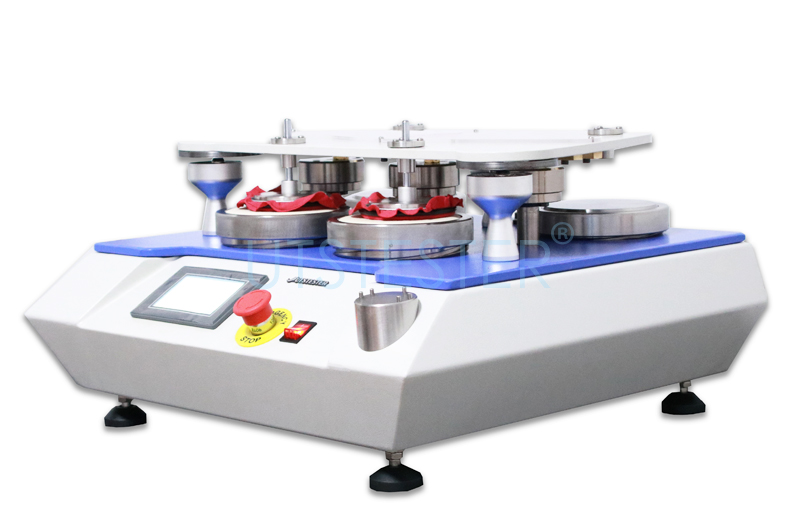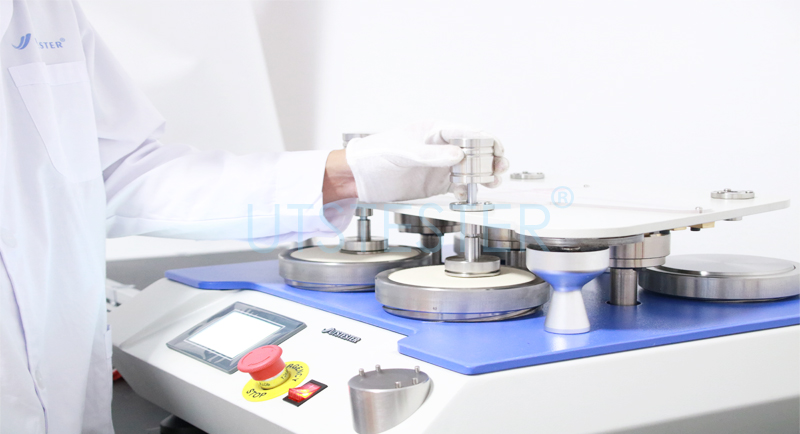 +86 152 6060 5085
+86 152 6060 5085
 +86 152 6060 5085
+86 152 6060 5085
Blog
Catalog
Latest Blog
Wear-resisting performance is an important index of textile product quality, which directly affects the durability and use effect of the product.To be specific, it refers to the characteristics of resistance to wear of fabric or other materials in the process of repeated friction.
The wear and tear of textile products is mainly manifested in the following five aspects
1. In the process of friction, the fiber fragments in the yarn will break due to fatigue damage, resulting in the breakage of the yarn.
2. The fiber is pulled out of the fabric, resulting in the looseness of the yarn and fabric structure. Under repeated action, the fiber may be pulled out completely, resulting in the yarn thinning, fabric thinning, or even disintegration.
3. The fiber is cut and broken, which leads to the breakage of yarn.
4. fiber surface wear, fiber surface debris loss.
5. friction produces high temperature, making the fiber melt or plastic deformation, affecting the structure of the fiber and mechanical properties.The main changes of wear in fabric are damage, quality loss, appearance discoloration, pilling and so on.
There are many methods for testing wear resistance of textile products, such as plain grinding, curved grinding, folding grinding and compound grinding.Martindale method is a kind of plain grinding method, which is widely used to test the wear resistance of clothing, household textiles, decorative fabrics and furniture fabrics.

Wear resistance evaluation method of fabric
The damage of the sample can be determined as follows: at least two independent yarns in the woven fabric are completely broken;A break in the appearance of a yarn in a knitted fabric;The surface nap of the raised or cut fabric is worn to the bare bottom or is tufted off;The diameter of holes caused by friction in nonwoven fabric is ≥0.5 mm;The coating portion of the coated fabric is damaged to expose the base cloth or the lamellar coating falls off.The wear-resisting property of fabric is generally analyzed and evaluated from three aspects: the determination of sample damage, the determination of quality loss and the evaluation of appearance change.
1. Determination of sample damage:
Under a certain load, the samples in the fixture were friction with Lissajous curve plane movement and abrasive material, and the total friction times when the samples were damaged were used to determine the wear resistance of the fabric.
2. Determination of quality loss:
Under a certain load, the samples in the fixture were subjected to friction with Lissajous curve plane motion and abrasives, and the wear-resisting performance was determined by the mass difference before and after friction at a specific friction number.
3. Evaluation of appearance changes:
Under a certain load, the samples in the fixture friction with the abrasive material through Lissajous curve plane movement in the track, and determine the wear resistance of the fabric by the appearance changes of the samples before and after the friction.
Review of testing methods for wear resistance of textiles
3.1 This method is applicable to all textile fabrics, but not to fabrics with short wear life.
1.the choice of abrasive
Different standard abrasives were selected according to the characteristics of the samples: uncoated fabric, woven plain wool fabric, coated fabric and No.600 water sandpaper.Wool felt is used to separate the abrasive material from the table. After the test, the surface of the felt should be inspected. If there are stains or wear, it should be replaced in time.
2. Sampling method
At least 3 pieces of woven fabric should contain different warp and weft yarns.Jacquard or fancy weave shall include characteristic parts of a fully woven fabric, which may be sampled separately when a fully woven or patterned fabric is large.
3. Selection of sample fixture gasket
The unit area of the sample is ≥500g/m2, and no foam liner is needed. The unit area of the sample is <500g/m2. The foam liner is installed in the sample fixture.
4. Selection of total effective mass of friction load
The total effective mass of friction load includes gripper, stainless steel disc and sample weight.According to the technical parameters of apailas M235Martindale abrasion resistance and pilling tester, the griper quality :(200±1) g;Stainless steel disc quality :(260±1) g;The weight of sample hammer :(395±2) g, (594±2) g.
According to the purpose of the sample, there are three kinds of total effective mass of friction load selected according to the fabric characteristics:
(1) (795±7) g: suitable for work clothes, furniture decoration cloth, bed linen, industrial fabrics.
(2) (595±7) g: suitable for use and home textiles (furniture upholstery cloth, bed linens), non-use coated fabrics.
(3) (198±2) g: suitable for wearing coated fabrics.
5. Abrasive replacement cycle of wool standard fabric: 50000 times;Standard water sandpaper: 6000 times.
6. The inspection interval is used to estimate the friction times when the samples reach the damage. On this basis, an appropriate inspection interval is designed to serve as the observation point of the surface wear state of the samples during the abrasion resistance test, and the inspection interval is a certain number of friction times.
7. The measurement results represent the total friction times when each sample is damaged, and the accumulated friction times before the sample is damaged are taken as the wear-resisting times.

3.2 determination of quality loss
Suitable for all textile fabrics, but not for fabrics with short wear life.The determination of abrasive selection, sampling method, sample fixture gasket selection, friction load total effective quality selection and abrasive replacement period requirements are consistent with the sample damage determination method, do not repeat the description here.
1. Check interval
An appropriate inspection interval is designed to be used as the observation point of the sample's surface wear state during the test of its wear resistance, and the inspection interval is a certain number of times of friction.During the test, the wear of the sample shall be checked according to the set inspection interval. When the sample is damaged or reaches the specified friction times, the test shall be completed.To the measurement of quality loss is divided into two cases: the first case, in each inspection interval, the quality of the test sample before and after wear test experiment of the difference of the quality of the sample Δ mi;The second case, to wear point, the quality of the test sample before and after wear test test of the difference of the quality of the sample Δ m.
2. Test results
-- determination of abrasion resistance of fabrics -- determination of mass loss -- test results include the following data:
(1) arrived at each inspection interval, the determination of the mass loss of Δ mi;
(2) sample to wear point, also is a test of the quality loss Δ when reaches the endpoint m;
(3) quality loss Δ mi relationship with the number of friction curve chart;
(4) (a/g), resistant index Ai calculation formula is: Ai = N/Δ miN - for the total number of friction.
3.3 appearance quality change
The method of change of appearance quality is suitable for textile fabrics with short wear life.The selection of abrasives, sampling methods and the selection of sample fixture liners are consistent with the determination of fabric sample damage.
1. Total effective mass of friction load (198±2) g;
2. Abrasive replacement cycle: replace new foam plastics and standard abrasives in each test;
3. Rules for evaluating the appearance change of samples:
(1) the number of times of friction shall be used as the measured value of wear resistance from the abrasion test to the surface changes specified in the agreement.Appropriate inspection intervals are designed to serve as observation points for the appearance changes of samples.
(2) wear test to the number of friction specified in the agreement, and evaluate the surface changes of the sample by comparing with the untested samples of the same fabric.
4. Test results: surface changes include discoloration, fuzz and pilling.If the end point of the wear resistance test is to achieve the surface change specified in the agreement, the test agreement shall specify the surface color change, fluff and pilling degree grades of the sample, and the test results shall be expressed by the number of friction times when the sample reaches the color change, fluff and pilling degree grades specified in the test agreement.If the end point of the abrasion test is the number of friction specified in the agreement, then the test result is that after the abrasion test reaches the specified number of friction, the test sample is compared with the original sample to rate the degree of color change, fuzz and pilling of the test sample.
Email: hello@utstesters.com
Direct: + 86 152 6060 5085
Tel: +86-596-7686689
Web: www.utstesters.com